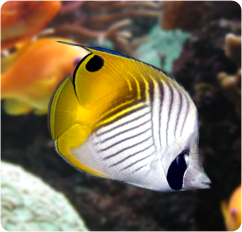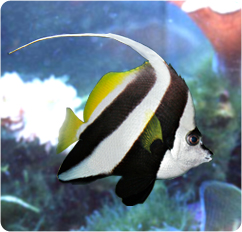|
Family Chaetodontidae - Butterflyfishes

Butterflyfishes from the family Chaetodontidae are some of the most interesting looking and beautiful fish in the marine aquarium hobby. While most of the 120-some-odd known species worldwide adapt poorly to the captive environment and should only be attempted by expert hobbyists, there are a few butterflyfishes that are remarkably beautiful and hardy. It is these butterflyfishes—ones like the Racoon Butterflyfish (Chaetodon lunula), the Teardrop Butterflyfish (Chaetodon unimaculatus), the Auriga Butterflyfish (Chaetodon auriga), the Black & White Heniochos (Heniochus acuminatus), and the Klein’s Butterflyfish (Chaetodon kleinii)—that are discussed here.
Butterflyfishes are built for reef life with a long snout and pancake body perfect for foraging the nooks and crannies. The size and shape of an individual butterflyfish’s jaw is an indication of its natural diet (usually coral polyps, small invertebrates, algae, and/or zooplankton. Butterflyfishes can be found in the tropical Indo-Pacific from Australia to Taiwan. At least four species live in the Eastern Pacific, and 13 species are indigenous to the Atlantic. They are generally brightly colored fish with contrasting markings that make them one of the more recognizable reef fishes. In many people’s minds, butterflyfishes are right up there with angelfishes in terms of their desirability in the hobby (in fact, they were once classified in the same group as angelfishes). Many butterflyfishes have a tell-tale eye spot on the back half of their body.

As you may have guessed from above, most (if not all) butterflyfishes are NOT considered reef compatible. While they might be a bad idea for a reef tank, they are undoubtedly an elegant choice for a fish only system. If you are committed to a so-called “reef safe” butterflyfish, try a Zoster Butterflyfish (Hemitaurichthys zoster). Many aquarists have also had luck with the Copperband Butterflyfish in a reef tank. Not only will they often leave most soft corals and small-polyped stony corals alone, they will also target pest Aiptaisia in the aquarium. Unfortunately, they can be tricky to care for given their sometimes finicky eating habits.
Husbandry
If you choose to keep a butterflyfish, do your best to follow these recommendations. First, begin with a large, mature aquarium (at least six months old) with plenty of swimming and hiding space. Most butterflyfishes like to roam, and each will appreciate a couple caves to call home. One of the reasons most butterflyfishes are not beginner fishes is because they absolutely must have excellent water quality (the other reason is their dietary needs). Skim, skim, skim…efficient protein skimming is a must with butterflyfishes, as is excellent biological filtration and massive amounts of current. Consider using a pH buffering substrate, as butterflyfishes prefer a high pH (although stability in pH is always the most critical factor). Most butterflyfishes will tolerate a range of temperatures from the mid-seventies to the mid-eighties (there are some temperate species; however, so do your homework).
Tankmates
Research individual species for compatibility issues, but keep in mind that butterflyfishes can get bullied to death in a tank with larger, aggressive tankmates. Some species will do okay with their own species, but most will fight unless the tank is very large.

Diet
Butterflyfishes are notoriously finicky eaters. Often new fish will only take live food, but most of the recommended species will take frozen food in time. They will want to be fed a varied marine diet, and they will appreciate frequent feedings. Meaty table seafood may be offered on occasion.
Disease and Infection
In terms of disease, butterflyfishes are very susceptible to all the usual suspects, although they do tend to respond well to the standard treatments. The biggest danger in terms of infection is often secondary to handling. Handle these fishes with care! They have sharp spines and slender snouts that can be damaged as a result of netting. These wounds often progress to infection and death. It is always a good idea to use a collection cup instead of a net if you must move your butterflyfish.

In Conclusion
In closing, butterflyfishes are magnificent, graceful animals that will be the envy on anyone observing your aquarium. Keep in mind that most are not beginner fish (in fact, most should not be attempted in captivity at all), but the few that we mentioned at the start of this article are good candidates if your up for the task of providing a home to one of these remarkable fishes.
|